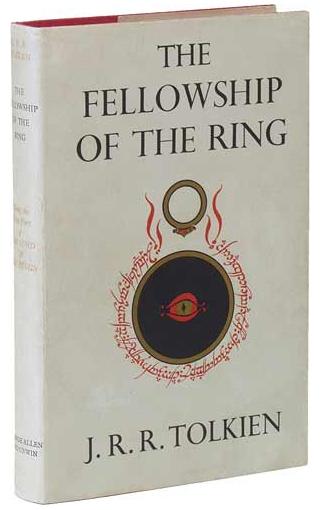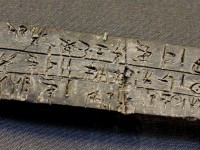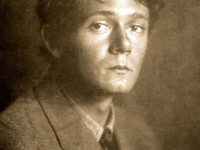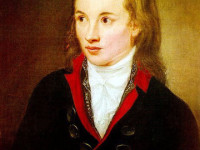
1st Edition cover of J.R.R. Tolkien’s ‘The Fellowship of the Ring’ (1954)
On July 29, 1954, the first volume of J.R.R. Tolkien’s epic fantasy story ‘The Lord of the Rings‘ was published. Ever since it has cast a spell over generations of readers. The Lord of the Rings has become one of the most popular books of the last century. But, who was this Oxford professor for Anglo-Saxon and why in the world did he come up with this terrific and rather unusual piece of writing? Actually, Tolkien‘s publisher initially thought that this “work of a genius” would only lose money. But he was proven wrong…
“When Mr. Bilbo Baggins of Bag End announced that he would shortly be celebrating his eleventy-first birthday with a party of special magnificence, there was much talk and excitement in Hobbiton.”
— J.R.R. Tolkien, The Fellowship of the Ring (1954), First sentence
In the Trenches of World War I
It was World War I. In 1916 Tolkien was sent to France, where he and his fellow soldiers faced the terrifying new mechanisms of modern warfare – machine guns, tanks, and poison gas – fighting in some of the bloodiest battles known to human history. Tolkien fought in the Battle of the Somme, in which over a million people were either killed or wounded. There, in the trenches of World War I, Tolkien began recording the horrors of war that would later surface in ‘The Lord of the Rings‘. In the same year he caught trench fever, an illness carried by lice, and was sent back to England for convalescence. In this time he began writing down the stories and mythology of Middle-earth, which would later form the basis for ‘The Silmarillion‘, which builds the mythological foundation of his success stories ‘The Hobbit‘ and ‘The Lord of the Rings‘.
While Marking Examination Papers…
Interestingly, according to his own account, Tolkien came up with the idea of the Shire and its native inhabitants, the hobbits one day when he was engaged in the soul-destroying task of marking examination papers. When he discovered that one candidate had left one page of an answer-book blank, (nobody in the world knows why, but) he wrote the now famous first sentence
‘In a hole in the ground there lived a hobbit. Not a nasty, dirty, wet hole, filled with the ends of worms and an oozy smell, nor yet a dry, bare, sandy hole with nothing in it to sit down on or to eat: it was a hobbit-hole, and that means comfort.‘
And it all began…
By 1918, all but one of my close friends were dead
In the foreword to the second edition of The Lord of the Rings, Tolkien wrote, “By 1918, all but one of my close friends were dead.”Although he wrote ‘The Lord of the Rings‘ story during World War II and Tolkien always strongly denied that it was meant as an allegory for the wars, the story follows the rise of a great evil threatening to envelop the world. Also the ring was not meant to symbolize the ultimative weapon, i.e. the atomic bomb. Likewise, the characters Sauron and Saruman, although both tyrants, are imaginary characters and are not meant to represent Hitler or Stalin.
Against Industrialization and Technology
Moreover, Tolkien had a strong concern for nature and ‘The Lord of the Rings‘ reveals his critical voice against the evils of industrialization and technology. While Saruman, the corrupt wizard, devastates the land and ancient forests as he builds up his army, the Elves, in contrast, live in harmony with nature, appreciating its beauty and power. Industrialization and technology can be identified with black magic. Treebeard, the Ent or tree-shepherd, says of Saruman, “He is plotting to become a Power. He has a mind of metal and wheels; and he does not care for growing things, except as far as they serve him for the moment.”
First it sold rather moderately
While the book first sold rather moderately after publication in England in 1954, it was not before the 1960s that the popularity of ‘The Lord of the Rings‘ suddenly exploded when a pirated version became available in the USA. Somehow, the story had hit a nerve. Readers recognized the resistance to political corruption and the preservation of the natural environment resonating as a challenge in their own lives. Even a sort of cult appeared, with people wearing buttons labeled FRODO LIVES or GANDALF FOR PRESIDENT.
“Three Rings for the Elven-kings under the sky,
Seven for the Dwarf-lords in their halls of stone,
Nine for Mortal Men doomed to die,
One for the Dark Lord on his dark throne
In the Land of Mordor where the Shadows lie.
One Ring to rule them all, One Ring to find them,
One Ring to bring them all and in the darkness bind them
In the Land of Mordor where the Shadows lie.”
— J.R.R. Tolkien, The Fellowship of the Ring (1954)
The Silmarillion
Tolkien spent the rest of his life working out the Silmarillion, which he did not complete until the end of his life, however, and which was only published by his son Christopher Tolkien after his death. For a few years he and his wife Edith moved to the English seaside resort of Bournemouth. There, Edith died in 1971, after which Tolkien moved back to Oxford. In 1972 he was awarded the rank of Commander of the Order of the British Empire by Queen Elizabeth II. Tolkien was also working on a sequel to The Lord of the Rings. It was intended to tell how, a few years after the death of the protagonists of the trilogy, a secret association of young people tried to give Sauron back his old strength. The novel fragment, which reflects the fears of youth religions that were widespread in the early 1970s, was published posthumously in 1996 under the title The New Shadow.
On September 2, 1973, Tolkien died at the age of 81 after a short illness in Bournemouth.
Michael D. C. Drout, Lord of the Rings: How To Read J.R.R. Tolkien, [7]
References and further Reading:
- [1] J.R.R. Tolkien – a biographical Sketch, from The Tolkien Society
- [2] Influences on The Lord of the Rings, from National Geographic
- [3] [in German language] ‘There and Back again‘, review for J.R.R. Tolkien’s ‘The Hobbit’ from the Biblionomicon
- [4] Works of J. R. R. Tolkien at Wikisource
- [5] The Encyclopedia of Arda: An Interactive Guide to the Works of J.R.R. Tolkien
- [6] J.R.R. Tolkien at Wikidata
- [7] Michael D. C. Drout, Lord of the Rings: How To Read J.R.R. Tolkien, Carnegie Mellon University’s Dietrich College @ youtube
- [8] Carpenter, Humphrey (1979). The Inklings: C. S. Lewis, J. R. R. Tolkien, Charles Williams and Their Friends. Boston: Houghton Mifflin.
- [9] Tyler, J. E. A. (1976). The Tolkien Companion. New York: Gramercy.
- [10] Shropshire County Council (2002). “J. R. R. Tolkien”. Literary Heritage, West Midlands.
- [11] Timeline for J.R.R. Tolkien, via Wikidata






thanks for sharing..